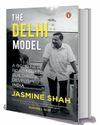
It is late in the evening and Kalkaji, one of the prominent neighbourhoods in south Delhi, is teeming with rush hour traffic as people head home from work. Soon, there is a break in the hustle as senior Aam Aadmi Party leader Manish Sisodia steps out from an SUV. Flanked by party workers raising slogans in support and holding aloft his posters, Sisodia, the former deputy chief minister of Delhi, is in the locality to launch his first padyatra after coming out of jail.
The busy crowd slows down to catch a glimpse of the leader who was recently released from jail on bail in the Delhi excise policy case, after 17 months behind bars. A woman pushes her way towards him, “We will never forget what you have done for our children,” she tells him, reminding the crowd about Sisodia’s stint as minister of education.
At regular intervals, volunteers chant the AAP’s new slogan, ‘Manish Sisodia aa gaye, Kejriwal bhi aayenge (Sisodia is back, Kejriwal, too, will follow)’ even as the song, ‘Mera Rang De Basanti Chola’, now featured in most AAP events, plays in the background. As Sisodia finds children lined up with placards welcoming him, he moves through the crowd to acknowledge their presence and gives them his blessings. Sisodia’s most talked about achievement came when he held the education portfolio, transforming the condition of government-run schools in the capital.
Since his release from jail, Sisodia has been on an outreach blitzkrieg through padyatras, meeting a large number of people. “I am overwhelmed to be welcomed as one of their family members,” he told THE WEEK in an exclusive interview (see page 29). He said his priority was to “reconnect” with the electorate. And rightly so, with the assembly elections in Delhi just six months away.
This story is from the September 15, 2024 edition of THE WEEK India.
Start your 7-day Magzter GOLD free trial to access thousands of curated premium stories, and 9,000+ magazines and newspapers.
Already a subscriber ? Sign In
This story is from the September 15, 2024 edition of THE WEEK India.
Start your 7-day Magzter GOLD free trial to access thousands of curated premium stories, and 9,000+ magazines and newspapers.
Already a subscriber? Sign In

Forging the future
As the curtain falls on 2024, I take pride in the extraordinary milestones achieved under the leadership of Prime Minister Narendra Modi. This year stands as a testament to the Modi government's resolve to forge a resilient and forward-looking Bharat. From groundbreaking advancements in infrastructure to visionary global initiatives, these efforts resonate deeply with the vision of Viksit Bharat.

Our strange democracy
Abraham Lincoln is lauded as among the very best presidents the US ever had: the statesman par excellence successfully steered the nation through the devastating and perilous years of the American civil war. Not only did Lincoln manage to keep his country united, he also ensured the passage of the 13th amendment to the US constitution, which abolished slavery.

Five years of post-pandemic fashion
It has been five years since we discovered what Covid-19 was, and five years since it disrupted the world forever. The World Health Organization activated their emergency systems on January 1, 2020, and informed the world by January 4, 2020. By the end of that week, they had set guidelines for various countries to follow. Comparable to the Spanish flu of 1918, more than 7 million people have died of Covid according to official data. Unofficially, no one has an idea. WHO has just this week asked China to provide critical data to understand the virus's origins as a “moral and scientific imperative”.

Community spirit
Rhythm of Dammam opens a window to the world of African-origin Siddis of Uttara Kannada

'Breaking' down a scandal
Society Girl is not just a case study of a high-profile death in Pakistan but also a stark commentary on media trials

Progress card
Jasmine Shah's book tells you what the AAP has achieved in Delhi in the last 10 years

SENSE IN NONSENSE
In his latest book of poetry, Ruskin Bond is at his funniest

Get ready for Trump bump
The ‘butterfly effect’ is a beautiful, mysterious metaphor of the planet’s interconnectedness.

QUIET FLOWS THE FAITH
The melding of an ancient amorphous faith and the latest science; of an antique tradition and new practices; ways of life older than memory and new expressions is happening at Prayagraj in Uttar Pradesh.

Trash to treasure
How a weed-choked Dal Lake spurred Maninder Singh's journey to become a waste management visionary